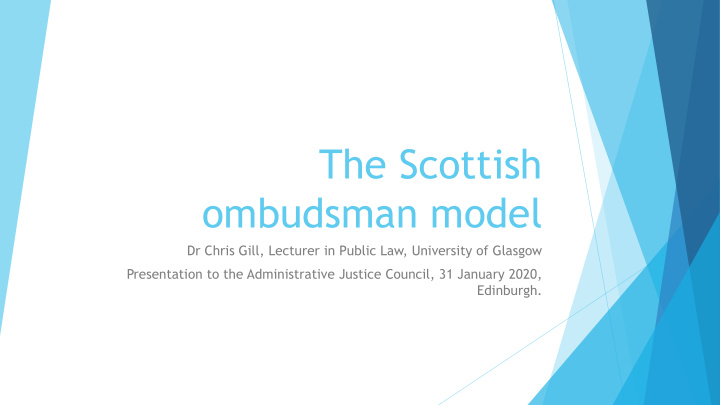



The Scottish ombudsman model Dr Chris Gill, Lecturer in Public Law, University of Glasgow Presentation to the Administrative Justice Council, 31 January 2020, Edinburgh.
Today Three distinctive features of the Scottish model: • One-stop-shop • Complaint Standards Authority • Multifunctionality The future of Scottish model • Own-initiative powers? • Relationship to the Scottish Parliament? • Human rights?
Distinctive features of the Scottish model
1. The one-stop-shop Health, local & devolved Social work government, Prisons & housing water Scottish Welfare Further & Healthcare Fund higher whistleblowing education 2002 2005 2010 2015 2016 2020 Simplicity Accessibility Coherence Efficiency
2. The Complaint Standards Authority Publishing model Publication of a statement Monitoring practice and complaint handling of complaint handling identifying any trends in procedures and making principles (approved by the way authorities handle declarations of non- Scottish Parliament) complaints compliance Encouraging co-operation Promoting best practice in and sharing of best relation to such complaint practice among handling authorities
3. Multi-functionality Regulation, monitoring, standard setting Welfare fund Complaint reviews handling and social work merits Whistleblowing
The future of the Scottish model
1. Own-initiative powers of investigation Should the SPSO be granted own-initiative powers? Value of own-initiative powers: • Addressing issues which are not complained about, as a result of a generally low propensity to complain; • Addressing issues which affect particularly vulnerable groups, which are especially unlikely to come to light through complaints; • Addressing matters of general public interest, which concern the fairness of administration, and are generally not the principal focus of other oversight bodies; and • Addressing and having a special responsibility for the operation of redress systems and taking on a broader “system fixing” role within the administrative justice system.
2. Relationship with the Scottish Parliament There is no equivalent to the Public Administration and Constitutional Affairs Committee in the Scottish Parliament Annual scrutiny by the Local Government and Regeneration Committee (and ad hoc appearances elsewhere) Focus to date has been on accountability of the ombudsman, rather than the ombudsman feeding into parliamentary scrutiny and deliberation Is the SPSO a ‘parliamentary ombudsman’?
3. Human rights Increasing focus on human rights in Scottish policy making and administration (e.g. Scottish Social Security Agency) Explicit human rights focus in Northern Ireland and increasing interest in Wales (e.g. human rights casebook) Global trend seeing parliamentary ombuds becoming more involved in human rights issues
Conclusion The Scottish model has been influential in devolved jurisdictions and has been a site of significant innovation within the UK and internationally. There is potential to enhance the model further and learn from other jurisdictions in relation to own-initiative powers, a more powerful relationship with the legislature, and a more explicit human rights mandate.
Recommend
More recommend